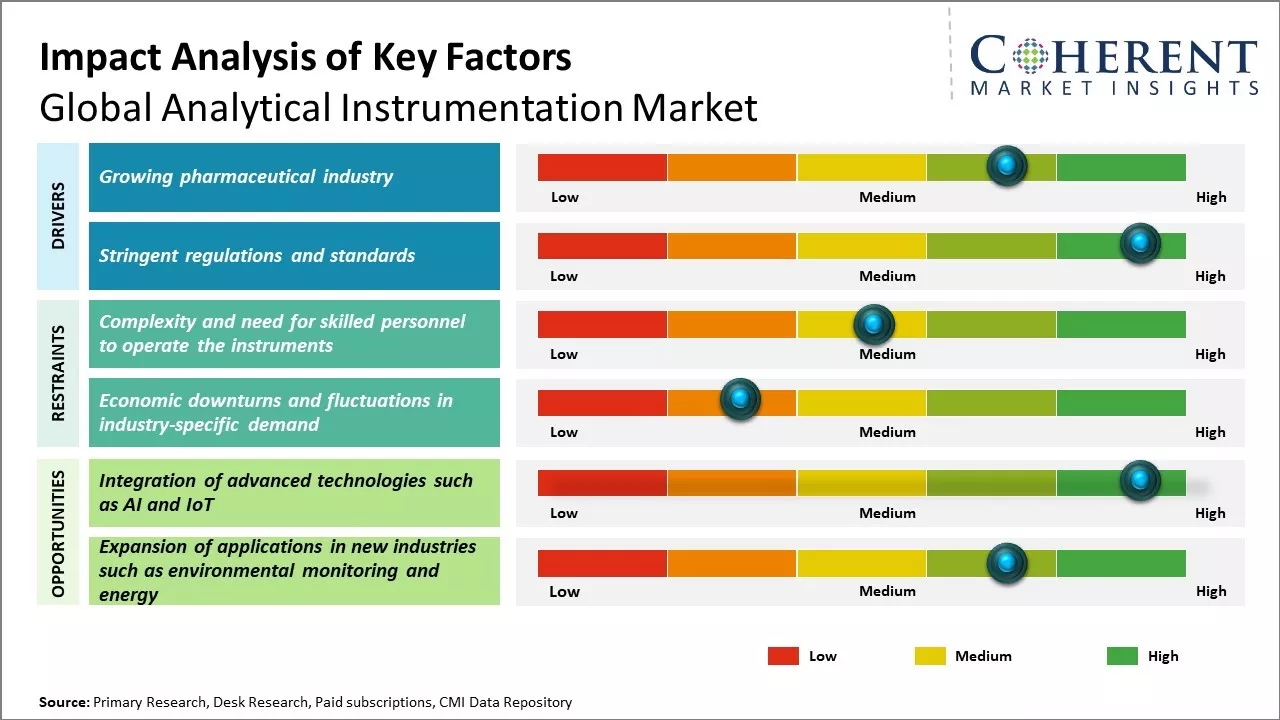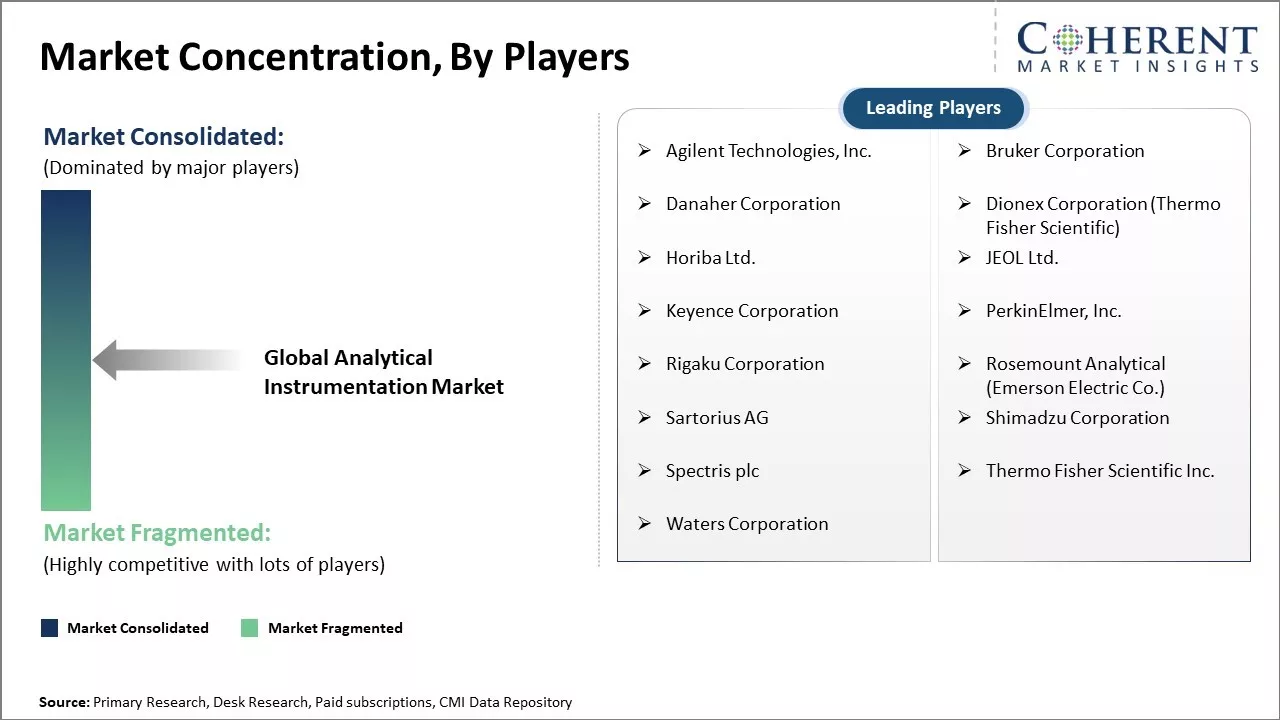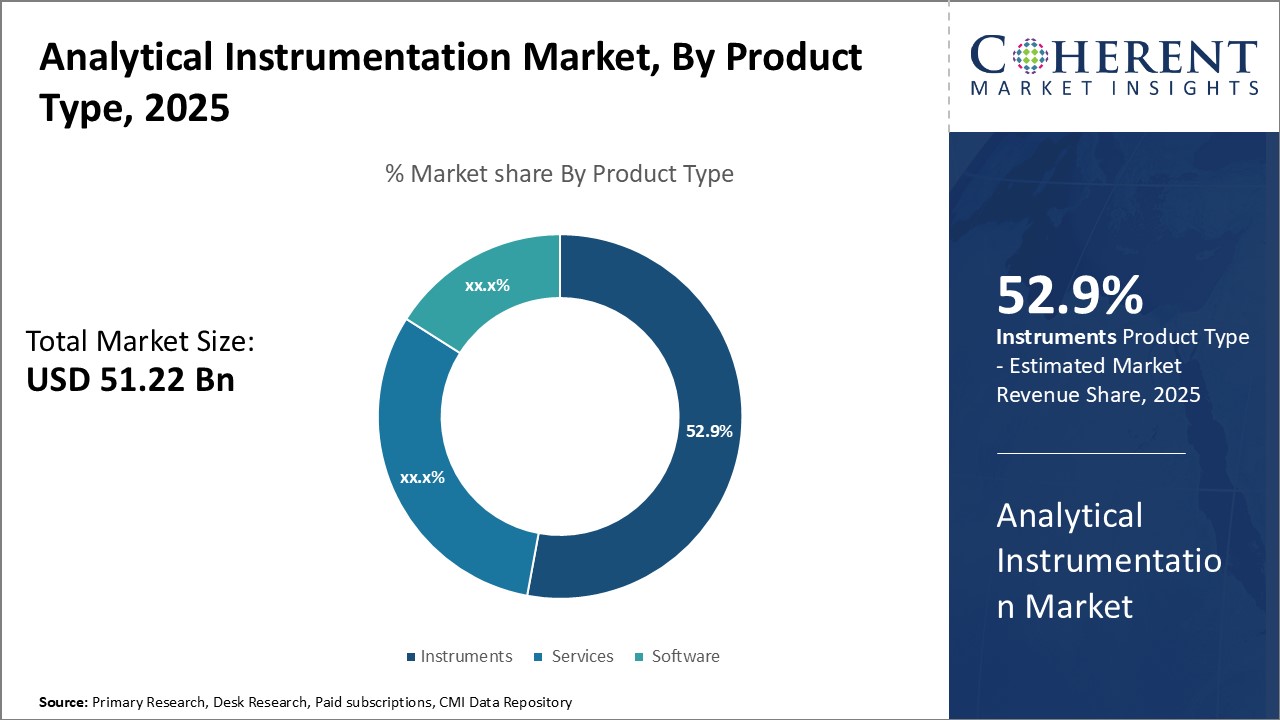The global analytical instrumentation market is estimated to be valued at US$ 51.22 Bn in 2025 and is expected to reach US$ 76.56 Bn by 2032, exhibiting a compound annual growth rate (CAGR) of 5.9% from 2025 to 2032.

Discover market dynamics shaping the industry: Download Free Sample
This growth can be attributed to the increasing demand for analytical instruments in various industries such as pharmaceuticals, food and beverage, and chemicals. Furthermore, the rising focus on research and development activities and the growing trend towards automation are also driving the market growth.
Market trends in the global analytical instrumentation market include the increasing adoption of advanced technologies such as mass spectrometry, chromatography, and spectroscopy. These technologies offer high accuracy, sensitivity, and specificity, making them essential in various industries for quality control, research and development, and process optimization. Additionally, the growing trend towards miniaturization and portability of analytical instruments is also driving the market growth, as these instruments offer increased convenience and mobility. Furthermore, the increasing focus on environmental analysis and the growing demand for real-time monitoring solutions are also expected to provide significant opportunities for market growth in the coming years.
Growing pharmaceutical industry
The pharmaceutical industry has been undergoing revolutionary changes over the past few decades. Developing novel drugs is now more important than ever to address the unmet needs of patients. Strict regulations also demand thorough testing and analysis at various stages of drug development. This has significantly increased the R&D spending of pharmaceutical companies on analytical instrumentation and services.
Sophisticated tools like chromatography, spectroscopy and lab automation systems are indispensable for drug discovery, formulation development, and quality testing. Chromatography techniques are heavily relied upon for separation, identification and quantification of molecules. High performance liquid chromatography or HPLC has emerged as the primary workhorse for analysis of small molecules. Size exclusion chromatography also finds applications in determining the molecular weights and sizes of proteins, polymers and biological macromolecules.
In the pre-clinical and clinical phases, various analytical methods come into play for chemical profiling, ensuring purity, assessing stability and measuring concentration of active pharmaceutical ingredients in biological matrices. Drug metabolism and pharmacokinetic studies require analytical work to determine absorption, distribution, metabolism, and excretion of potential drug candidates. Scale up and commercial manufacturing activities are closely monitored through analytical testing to guarantee batch-to-batch consistency and compliance with stringent quality specifications.
Comprehensive testing and release of final drug products demands analytical capabilities for dissolution, impurities analysis and content uniformity testing. Bioanalytical applications have witnessed rapid growth too for measuring drugs and metabolites in blood, plasma or tissue samples obtained from pre-clinical and clinical studies. All these expanding responsibilities have driven pharma companies to invest more in advanced analytical instruments, assays and skilled personnel.
The instrumentation market is thus propelled by the escalating analytical requirements of the pharmaceutical industry engaged in innovative drug discovery and developing complex biologics. Intensifying regulation globally and emerging healthcare needs have prompted more R&D expenditures towards safety, efficacy and quality testing - benefiting vendors of analytical equipment and services.

Get actionable strategies to beat competition: Download Free Sample
Stringent regulations and standards
Regulatory compliances have become more rigorous across various industries relying on analytical testing for quality assurance. Be it pharmaceuticals, food and beverage, chemicals or even environment monitoring - regulators worldwide are raising the bar to ensure consumer safety and protection. Stricter mandates signify the need for approved analytical methods, certified reference materials, method validations and demonstrable compliance to Good Laboratory or Manufacturing Practices.
FDA and EU guidelines now emphasize on risk-based approaches for process validation and quality by design principles during product development. Pharmacopeial monographs too are advancing to stipulate analytical specifications in sync with latest scientific advances. Laboratory accreditations to ISO/IEC 17025 are gaining prominence for demonstrating technical competence and assuring quality of test results. Meanwhile, industry associations are crafting industry-specific compendial methods and reference standards to simplify adherence to regulatory expectations.
At the same time, advancements in areas like precision and personalized medicine necessitate analytical instruments and platforms with higher throughput, accuracy and quantitative abilities. Technological innovations are enabling miniaturization, portability, automation as well as multi-dimensional analyses. Sophisticated scientific instrumentation incorporating such modern capabilities allows generating reliable data mandated by regulatory filings for approval. It also helps addressing analytical challenges of complex formulations, biosimilars as well as next generation biotherapeutics.
In a compliance-focused market atmosphere, stakeholders need to upgrade analytical methods and invest in new assays, software, and sample preparation tools to satisfy information expectations of regulators, assessors, and standards organizations. This drives strong demand for state-of-the-art as well as customizable and flexible analytical solutions among various regulated industries. Instrument vendors, in turn, are spurred to innovate and offer reliable analytical technologies, services and technical expertise to facilitate regulatory compliance globally.
Key Takeaways from Analyst:
The Global Analytical Instrumentation Market is witnessing robust growth, fueled by several key drivers and opportunities. This market caters to various industries, including pharmaceuticals, food and beverage, chemicals, and environmental, among others, providing solutions for accurate and efficient analysis of substances and materials.
Firstly, the increasing focus on research and development (R&D) in various industries is driving the demand for advanced analytical instrumentation. These instruments enable companies to gain deeper insights into their products and processes, ultimately leading to improved quality and innovation.
Secondly, the growing trend towards automation and miniaturization in analytical instrumentation is opening up new opportunities for market growth. Miniaturized instruments offer advantages such as portability, ease of use, and lower costs, making them increasingly popular in applications where on-site analysis is required.
Moreover, the healthcare sector is expected to be a significant contributor to the market's growth. The need for accurate and rapid diagnosis and monitoring of diseases is leading to increased adoption of advanced analytical instruments in this sector.
However, the market also faces certain challenges. The high cost of analytical instruments and the need for skilled personnel to operate them are major restraints. Additionally, the presence of a large number of market players and the intense competition among them can make it difficult for new entrants to establish a foothold.
Asia Pacific is currently the fastest-growing region in the global analytical instrumentation market. The region's large and growing industrial base, coupled with increasing R&D investments and a growing focus on automation, are key factors driving the market's growth in this region.
In conclusion, the global analytical instrumentation market is poised for dynamic growth, driven by technological advancements, increasing demand for precision analysis, and the growing trend towards automation and miniaturization. Despite challenges, opportunities abound, particularly in the healthcare sector and the Asia Pacific region.
Market Challenges: Complexity and need for skilled personnel to operate the instruments
The complexity of modern analytical instruments is one of the major factors restraining the growth of the global analytical instrumentation market. Analytical instruments today come equipped with advanced technologies like robotics, artificial intelligence, machine learning etc. to enable highly sensitive and accurate analysis of samples. However, operating such sophisticated equipment requires personnel with higher education and extensive training. Getting acquainted with the complex interfacing, precise sample preparation steps, appropriate method development procedures and intricate data analysis processes takes a significant amount of time. This shortage of skilled workforce has been restricting wider adoption of analytical instruments especially in underdeveloped regions.
Moreover, the need for frequent upgradation of skills as per evolving technology also poses challenges in human resource management for instrument users. Traditional educational courses often fail to keep up with the rapid pace of innovation in analytical instrumentation. This hinders optimum utilization of new instruments and analyzing an expanding scope of parameters. Users have to invest substantial resources for continuous education and hands-on sessions to maximize their problem-solving capabilities. The associated recurring costs negatively impact return on investment considerations for analytical instrumentation.
Market Opportunities: Integration of advanced technologies such as AI and IoT
The integration of advanced technologies such as artificial intelligence (AI) and internet of things (IoT) provides tremendous opportunities for growth in the global analytical instrumentation market. With AI and IoT, analytical instruments can be designed for higher levels of automation, remote operation, and data-driven insights.
AI-powered analytical devices can leverage machine learning algorithms to analyze samples autonomously and generate reports with precise diagnostic results. This significantly improves productivity and efficiency as human researchers are freed from routine data collection tasks. AI also enables predictive maintenance of instruments by detecting performance anomalies from sensor data. This ensures optimal upkeep of expensive lab equipment and minimizes disruptions.
The integration of IoT brings analytical devices online, allowing remote monitoring and control. Scientists can operate highly specialized instruments from any location via internet connectivity. Real-time data streaming from networked analytical devices aids collaborative research across geographic boundaries. IoT also facilitates the growth of smart labs where all instruments, utilities, and infrastructure can be centrally managed on a digital platform. This drives consistency in experiment protocols and regulatory compliance.

Discover high revenue pocket segments and roadmap to it: Download Free Sample
Insights By Product Type - Superior analytical capabilities drive instruments’ growth
In terms of product type, instruments is expected to contribute 52.9% share of the global analytical instrumentation market in 2025. This dominance can be attributed to several key factors. Firstly, instruments play a crucial role in the analysis of various samples across different industries. They provide accurate and reliable data, enabling researchers and scientists to make informed decisions. Instruments are used extensively in fields such as life sciences, clinical diagnostics, food and beverage analysis, and environmental testing, among others. The versatility and applicability of analytical instruments make them an indispensable tool in these industries.
Secondly, the ongoing research and development in the field of analytical instruments have led to the launch of advanced and sophisticated instruments. These new-age instruments offer higher precision, faster analysis, and improved accuracy, making them a preferred choice for researchers and scientists. Additionally, the integration of automation and digital technologies in analytical instruments has further boosted their adoption, as they offer increased efficiency and ease of use.
Lastly, the increasing focus on research and development activities, particularly in the life sciences sector, is driving the demand for analytical instruments. With the growing emphasis on personalized medicine and precision healthcare, there is a rising need for advanced analytical tools to develop new drugs and therapies. Moreover, the increasing regulatory requirements for quality control and compliance in various industries are also fueling the demand for analytical instruments.
Insights By Technology - Pioneering innovations fuel polymerase chain reaction’s prominence
In terms of technology, polymerase chain reaction is expected to contribute 40.3% share of the global analytical instrumentation market in 2025. PCR is a widely used molecular biology technique for the amplification of specific DNA sequences. The technology's popularity can be attributed to its high sensitivity, specificity, and accuracy. PCR is used extensively in various applications, including genetic testing, diagnosis of infectious diseases, and research in the life sciences sector.
One of the primary drivers of the growth of the PCR segment is the increasing demand for molecular diagnostics. With the rising prevalence of various infectious diseases and genetic disorders, there is a growing need for accurate and rapid diagnostic tools. PCR offers a quick turnaround time and high accuracy, making it an ideal choice for molecular diagnostics. Additionally, the ongoing research and development in the field of PCR have led to the launch of advanced PCR systems, offering higher throughput and improved automation.
Another factor driving the growth of the PCR segment is the increasing adoption of the technology in research applications. PCR is used extensively in gene expression analysis, genotyping, and mutation analysis, among other applications. With the growing emphasis on personalized medicine and precision healthcare, there is a rising need for advanced analytical tools to develop new drugs and therapies. PCR offers a cost-effective and efficient solution for gene analysis, making it a preferred choice for researchers.
Insights By Application - Vital insights accelerate life sciences research & development
In terms of application, life sciences research & development is expected to contribute 42.1% share of the global analytical instrumentation market in 2025. The dominance of this segment can be attributed to several factors. Firstly, the life sciences sector is witnessing a rapid pace of innovation and research, with a focus on developing new drugs, therapies, and diagnostics. Analytical instrumentation plays a crucial role in this research, providing accurate and reliable data for the development of new products.
Secondly, the increasing regulatory requirements for quality control and compliance in the life sciences sector are driving the demand for analytical instrumentation. With the growing emphasis on personalized medicine and precision healthcare, there is a need for advanced analytical tools to ensure the quality and safety of drugs and therapies. Additionally, regulatory bodies are imposing stringent guidelines for the development and approval of new drugs and therapies, which necessitates the use of advanced analytical instrumentation.
Lastly, the ongoing research and development in the field of analytical instrumentation have led to the launch of advanced and sophisticated instruments specifically designed for the life sciences sector. These new-age instruments offer higher precision, faster analysis, and improved accuracy, making them an indispensable tool for researchers and scientists in the life sciences sector. Additionally, the integration of automation and digital technologies in analytical instruments has further boosted their adoption, as they offer increased efficiency and ease of use.

Need a Different Region or Segment? Download Free Sample
The North America region has long been a dominant player in the global analytical instrumentation market. The region is expected to account for 44.0% of the market share in 2025. The region's advanced industrial sector and robust research and development activities have fueled the demand for analytical instruments. The presence of key market players, including Agilent Technologies, Thermo Fisher Scientific, and Shimadzu Corporation, in this region further strengthens its position.
Moreover, the region's well-established healthcare sector, which relies heavily on analytical instruments for diagnostics and research, is another significant contributor to the market's growth. The U.S. Food and Drug Administration (FDA) plays a crucial role in ensuring the safety and quality of food, pharmaceuticals, and medical devices, further increasing the demand for analytical instrumentation.
The Asia Pacific region is currently the fastest-growing market for analytical instrumentation. The region's rapidly developing economies, particularly China and India, are driving the growth in this market. The increasing industrialization and urbanization in these countries have led to a surge in demand for analytical instruments in various sectors, including pharmaceuticals, food and beverage, and electronics.
The region's large and growing population base is another significant factor contributing to the market's growth. The increasing awareness of health and wellness, coupled with the rising disposable income, has led to an increase in demand for diagnostic and analytical instruments in the healthcare sector.
Furthermore, the region's favorable business environment, with low labor costs and lenient regulatory frameworks, has attracted several international players to set up manufacturing bases in countries like China and India. This has led to an increase in the production and export of analytical instruments from these countries, making them significant players in the global market.
In conclusion, the North American and Asia Pacific regions are the dominating and fastest-growing markets for analytical instrumentation, respectively. The North American market's dominance can be attributed to its advanced industrial sector, robust research and development activities, and the presence of key market players. In contrast, the Asia Pacific region's rapid growth can be attributed to its developing economies, large population base, and favorable business environment.
Analytical Instrumentation Market Report Coverage
| Report Coverage | Details | ||
|---|---|---|---|
| Base Year: | 2024 | Market Size in 2025: | USD 51.22 Bn |
| Historical Data for: | 2020 To 2024 | Forecast Period: | 2025 To 2032 |
| Forecast Period 2025 to 2032 CAGR: | 5.9% | 2032 Value Projection: | USD 76.56 Bn |
| Geographies covered: |
|
||
| Segments covered: |
|
||
| Companies covered: |
Agilent Technologies, Inc., Bruker Corporation, Danaher Corporation, Dionex Corporation (Thermo Fisher Scientific), Horiba Ltd., JEOL Ltd., Keyence Corporation, PerkinElmer, Inc., Rigaku Corporation, Rosemount Analytical (Emerson Electric Co.), Sartorius AG, Shimadzu Corporation, Spectris plc, Thermo Fisher Scientific Inc., and Waters Corporation |
||
| Growth Drivers: |
|
||
| Restraints & Challenges: |
|
||
Uncover macros and micros vetted on 75+ parameters: Get instant access to report
*Definition: The global analytical instrumentation market refers to the industry that produces and supplies a range of advanced instruments used for the chemical, physical, and biological analysis of various substances. These instruments enable researchers, scientists, and industrial professionals to identify, quantify, and characterize components in complex matrices for applications in fields such as pharmaceuticals, food and beverage, environmental testing, and academic research. The market encompasses technologies like chromatography, mass spectrometry, spectroscopy, and microscopy, among others, and continues to evolve with innovations in automation, miniaturization, and data analysis software.
Share
Share
About Author
Suraj Bhanudas Jagtap is a seasoned Senior Management Consultant with over 7 years of experience. He has served Fortune 500 companies and startups, helping clients with cross broader expansion and market entry access strategies. He has played significant role in offering strategic viewpoints and actionable insights for various client’s projects including demand analysis, and competitive analysis, identifying right channel partner among others.
Missing comfort of reading report in your local language? Find your preferred language :
Transform your Strategy with Exclusive Trending Reports :
Frequently Asked Questions
Joining thousands of companies around the world committed to making the Excellent Business Solutions.
View All Our Clients